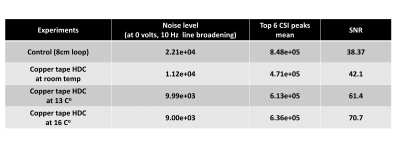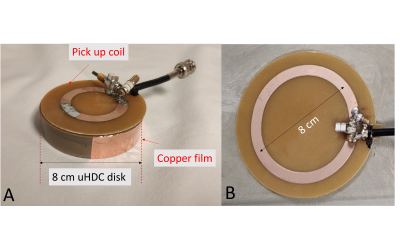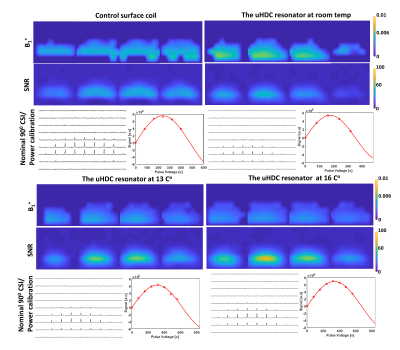4506
Dielectric transreceiver resonant coil using an ultrahigh εr ceramic disk for 17O imaging at 10.5T and comparison with a single-loop surface coil1Center for Magnetic Resonance Research (UMN), Minneapolis, MN, United States
Synopsis
We integrated a permittivity-tunable ultrahigh dielectric constant (uHDC) disk with copper film shielding (for tuning) and a pick-up coil (for matching) for performing 17O MRS imaging (MRSI) at 10.5T. We conducted a phantom 17O imaging study to compare the coil performance and signal-to-noise ratio between the newly designed uHDC resonator with a surface loop coil of the same diameter as the disk. The results indicate a better performance of the uHDC resonator at the room temperature(21 Co), and a much better performance when the ceramic disk temperature was cooling to 16 Co, owing to a large denoising effect.
Introduction
The RF coil sensitivity and magnetic field (B1) can be significantly enhanced by integrating the ultrahigh dielectric constant (uHDC, εr >1000) ceramics with a RF coil owing to the contribution from the displacement current when the ceramic permittivity is high.1 Alternatively, the HDC/uHDC ceramics is commonly characterized by multiple intrinsic resonant modes. The resonant mode frequencies depend on the material property, ceramic geometry and permittivity, and could be adjusted using a partial shield around the ceramic disk, for instance, by a thin copper film, therefore, the ceramic disk could act a resonant coil using one of the intrinsic resonant modes.2 This concept has been demonstrated for human breast MRI using a HDC ceramic cylinder surrounding the breast at 3T, however, the imaging signal-to-noise ratio (SNR) was similar with a traditional local RF coil despite of several times of B1+ improvement as compared to a body transmission coil.3 Recently, we have reported the permittivity tunable ceramics made of composite barium strontium titanate (BST) compounds (Ba0.6Sr0.4TiO3) by changing the ceramic temperature, which providing the best performance at 15 Co for a 17O surface coil, showing largely enhanced B1 field, >50% denoising effect and large SNR gain at 10.5T.1In this study, we applied the pick-up coil to drive the same BST-based uHDC ceramic disk as a RF transreceiver resonant for acquiring 17O MRS imaging at 10.5T using a water solution phantom, then compare the performance at room and low disk temperature with a single-loop surface coil with the same diameter.
Methods
Figure 1 shows the BST-based uHDC ceramic disk (8 cm diameter and 2 cm thickness) resonator and control coil (8-cm diameter) surface loop coil.1 A copper film was partially taped on the uHDC disk edge for shifting the intrinsic resonant frequency from 80 MHz to 60.6 MHz (17O Larmor frequency at 10.5T). A pick-up coil (5cm diameter) was placed on the bottom of the disk, and the phantom (8cm in diameter, 5.6 cm in height, containing 77 mmol NaCl) is placed on the top of the uHDC disk. Using the copper film and pick-up coil, we can tune and match the uHDC resonator to 60.6 MHz either at room or low disk temperature for acquiring 3D 17O CSI under fully relaxed condition on a Siemens 10.5T human scanner.We conducted the CSI experiments with the uHDC resonator under three uHDC disk temperature conditions: 1) 13 Co , 2) 16 Co , and 3) 21 Co. Following the experiments, we conducted the control experiment using the 8cm surface loop coil. The CSI noise level, and the mean of 6 CSI voxels with highest signal intensity for different conditions are summarized in Table 1.
Results
The CSI results are summarized in Table 1, which shows ~50 % noise level reduction using the uHDC disk (8 cm diameter and 2 cm thickness) resonator as compared to the 8-cm diameter loop coil at room temperature. On the other hand, the CSI amplitudes were reduced by 40 %, thus, resulting in ~10% improvement in SNR. Strikingly, when cooling the uHDC disk temperature to 13-16 Co, the CSI noise level was further reduced and the signal intensity increased, thus, achieving a large SNR gain, for instance, 84% at 16 Co and 60% at 14 Co (Table 1). The 16 Co of the uHDC disk gives the best noise level and SNR. This finding is consistent with our previous work,1 where the lowest noise level and highest SNR was observed at 15 Co. Figure 2 shows the B1+ , SNR maps, nominal 90o, and power calibration for the same dataset shown in Table 1. The uHDC resonator has a distinct B1+ profile: the high B1+ field strength at the center of the disk surface. For the control 8cm coil, high level of B1+ field strength stayed on the sides of the coil surface. The uHDC resonator at room temperature has higher B1+ transmit efficiency, in contrast, the uHDC disk at 16 Co shows the best SNR across the entire imaging volume.Discussion and Conclusion
Using the combined techniques of copper film and pick-up coil, we can tune and match the uHDC resonator frequency to a desired Larmor frequency for 17O MRSI application at 10.5T. Shielding the UHDC disk edge with copper film does not destroy the resonator behaviors of the uHDC disk. In the copper film shielding condition, our electromagnetic simulations showed standing wave behaviors of B1 field inside the uHDC disk. Under the optimal disk temperature (16 Co), the uHDC resonator could largely improve the SNR by > 80% as compared to the traditional surface loop coil with the same diameter. Such large SNR improvement observed for the 17O MRSI at 10.5T could be translatable to the proton MRI application at a clinical MRI field strength of 1.5T owing to the very similar Larmor frequencies between them.1Acknowledgements
NIH Grants: U01EB026978, R01CA240953, R01MH111413, P41 EB027061, and S10 RR029672.References
1. Chen, W., et al., Tunable Ultrahigh Dielectric Constant (tuHDC) Ceramic Technique to Largely Improve RF Coil Efficiency and MR Imaging Performance. IEEE Trans Med Imaging, 39:3187-3197 (2020).
2. Ruytenberg T, Webb AG. Design of a dielectric resonator receive array at 7 Tesla using detunable ceramic resonators. J Magn Reson. 284:94-98 (2017).
3. Shchelokova, A., et al. Ceramic resonators for targeted clinical magnetic resonance imaging of the breast. Nat Commun 11, 3840 (2020).
Figures


